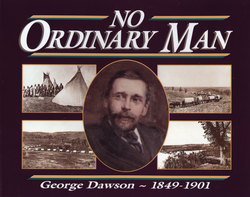Читать книгу No Ordinary Man - Lois Winslow-Spragge - Страница 7
На сайте Литреса книга снята с продажи.
ОглавлениеEDITOR’S INTRODUCTION
As one deeply involved in research on George Mercer Dawson for over a decade, it is indeed a pleasure for me to edit this new edition of Mrs. Lois Winslow-Spragge’s work. Her obvious admiration of her beloved uncle made the earlier volume a touching tribute to “the little Doctor.” Now, in the present edition it is hoped a wider audience will come to appreciate George Mercer Dawson, one of Canada’s most remarkable yet unsung heroes. While George Dawson is often lauded as Canada’s foremost scientific mind of the latter nineteenth century, few Canadians know the man except for his namesakes such as Dawson Creek, British Columbia, and Dawson City, Yukon.
Who was George Mercer Dawson? Dawson was the pioneer geologist of western Canada. He trekked through vast tracts of that largely uncharted territory from his appointment with the Geological Survey of Canada in 1875, making precise observations which were later synthesized into the foundational geological studies of the area. He was also distinguished as a leader, and was director of the Geological Survey of Canada from 1895 until his death in 1901. George’s geological expertise was matched by accomplishments in a variety of other subjects including flora, meteorology, and especially ethnology. On his explorations, Dawson took a particular interest in Indian cultures and purchased numerous artifacts for inclusion in such museums as the McCord in Montreal. His detailed field observations formed the basis for several well-respected studies of Indian life. In whatever subject he addressed, George brought to bear a uniquely gifted ability for analysis and a penchant for exacting detail. His intellectual attainments are astounding.
Behind George Dawson the scientist, is a remarkable person. Along with his mental capabilities George displayed a confident social presence. Even while a young London student at the Royal School of Mines, George socialized with his eminent professors such as Charles Lyell and T.H. Huxley. Later, on western expeditions, he intermingled with Victoria’s social elite, including the Creases and the Helmckens. In spite of this extensive socializing, he freely but confidentially admitted that he disliked social events! As his scientific stature rose, Dawson was also warmly accepted as a colleague by the most respected scientists of his era. He held many positions of influence in prominent scientific organizations and won numerous awards and distinctions. Dawson was also renowned as a witty companion who could keep audiences enthralled with tales of frontier adventure. Clearly, George Dawson’s intellectual acumen was complimented by a warm and engaging personality.
George Dawson, however, remained an intensely private individual who developed few close relationships. Dawson’s immediate family was always the focus of his life. From the childhood admonitions of his devoutly Christian grandfather James Dawson, to the mature interchange of ideas with his father J.W. Dawson, family members were his profound influences. While close to other family members, George maintained an especially intimate relationship with his sister, Anna. Their childhood sharing of numerous interests grew into a mutually loving and respectful friendship. They remained the deepest of friends even though she married and had nine children, and he travelled extensively. George was always involved, offering emotional and financial support to his cherished sister. Unmarried and never living in his own home, George found lasting personal sustenance within his family. The Dawson family provided George with a firm base upon which to develop his rare capabilities.
George Dawson lived life to its fullest despite questioning his own abilities and motives, and in spite of obvious physical limitations resulting from a deforming childhood disease. His brilliant intellect vigorously applied, produced a substantial body of excellent writings. His stupendous endurance in field explorations vividly illustrated George’s amazing stamina. And, his obvious and affectionate concern for family revealed George as a tender and loving brother and son. Indeed, George Mercer Dawson was an “extraordinary” man.
In the present edition the editor has built upon the earlier volume of Mrs. Winslow-Spragge. As in the earlier work, this volume is not intended to be an analytical biography of George Dawson but a portrait reflecting his interesting and varied life. Significant departure from Mrs. Winslow-Spragge occurs where the present edition uses complete letters and diaries in contrast to her brief and isolated quotations. Also, some material deemed superfluous to Dawson’s major intellectual achievements was deleted. Re-organization of the text’s order was undertaken to develop a smoother transition of subjects. Brief footnotes have been added, where possible, to clarify the text for the modern reader. Dawson’s writings also have been reproduced as accurately as possible so that minor errors of punctuation, capitalization, and spelling are not corrected.
In preparing the present volume the assistance is acknowledged of the Documentary Art & Photography Division, National Archives of Canada, McCord Museum of Canadian History, Notman Photographic Archives, and John Summers of the Marine Museum of Upper Canada. Also, the editor has utilized much material originally written by Douglas Cole of Simon Fraser University in his and the editor’s earlier work on Dawson. Finally, sincere thanks must be extended to Phoebe Chartrand and Rob Michel of the McGill University Archives for their expert knowledge of the Dawson family and Dawson manuscripts, and their unfailingly helpful assistance.
The following editorial symbols have been used in the present edition:
Material cancelled in manuscript <...>
Material inserted in manuscript {...}
Illegible reading [... ]
Conjectural reading [conjecture]
